
Whether you are new to the industry or a defence industry veteran, Kinexus’ Defence Industry Insights provides valuable information about what’s going on across the plethora of acquisition and sustainment projects and the key factors affecting the workforce.
In this series of blogs, we take a deep dive into what is going on in each sector. Today we explore the aerospace sector.
For further information download the Eighth Edition of Kinexus’ Defence Industry Insights.
AEROSPACE SECTOR OVERVIEW
Hiring in the aerospace sector is being driven largely by acquisition activities.
The F-35 platform requires a significant support workforce in Williamtown, NSW, especially across logistics, supply chain and simulation skill sets.
The Hunter region is kept busy on the disposal of the F/A-18 Hornet, the introduction of the F-35, and the sustainment of the E-7A Wedgetail. This region’s employers, educators and various levels of government have, through advanced stakeholder collaboration, demonstrated some of the innovative approaches to workforce development that may be required in other parts of the country.
Ongoing air traffic management project work in Melbourne adds to the demand for systems engineers, schedulers and configuration managers in that location.
Over the past 12 months the aerospace sector has supplemented its workforce by hiring from the commercial aerospace industry, and anecdotal evidence shows that these transitions have been successful. However, adjacent industries such as rail, infrastructure and transport have found the defence aerospace sector to be a healthy hunting ground for well-skilled talent, as their usual supply of overseas hires has been temporarily stalled due to the COVID-19 pandemic.
AEROSPACE WORKFORCE INSIGHTS
In April 2021 we surveyed the defence industry workforce. Here are some key workforce insights for the aerospace sector.
Industry Career Confidence
This chart shows the opinion of the aerospace sector respondents when asked ‘What is your current confidence in defence industry being able to provide you with a long-term career?’

Confidence in long-term defence industry career opportunity is extremely high. Nationally across all sectors, 88% of respondents feel somewhat or very confident. The chart shows that sentiment within the aerospace sector is in line with this.
Employment Changes in the Near Future
This chart shows the opinion of the aerospace sector respondents when asked ‘Are you considering a change in employment in the near future?’

The sentiment within aerospace sector respondents is broadly in line with sentiment across all sectors. 40% of aerospace sector respondents answered that they would look for work immediately or in the next 12 months, which is 5 percentage points higher than the average across all sectors.
Job Satisfaction
This graph displays the opinion of the aerospace sector respondents when asked ‘What has the most impact on your job satisfaction?’ Respondents were asked to select their top five.
The percentages show the proportion of respondents that feel the factors below contribute most to their job satisfaction.

Those in the aerospace sector value interesting work, work life balance and remuneration as the top three factors that contribute to job satisfaction, which is in line with the broader defence industry population across all sectors.
Want to know more?
Further detail is available in Kinexus’ Defence Industry Insights – Eighth Edition which is available now to download for free.
For additional insight and to explore what the data means for your hiring activity and your defence industry organisation at large, get in contact with our consultants today.






